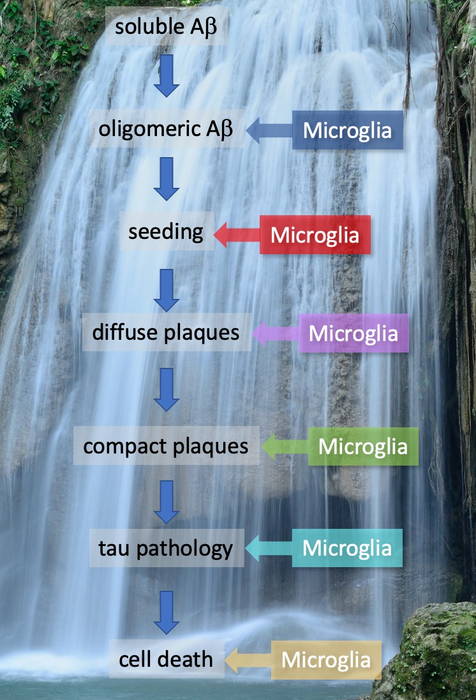An estimated 50 million people around the world have Alzheimer’s disease (AD), and perhaps twice that number are unknowingly “incubating” the disease during its long presymptomatic period. The total cost of caring for AD patients in the US exceeds that for all cases of heart disease or cancer. Yet there is only one disease-modifying therapy approved in the US (but not elsewhere), and controversy surrounding both its target, amyloid, and its efficacy has severely limited its use. In this up-to-the-minute assessment, publishing July 21st in the open access journal PLOS Biology, Christian Haass at the German Center for Neurodegenerative Diseases in Munich and Dennis Selkoe at the Harvard Medical School, United States, who have long worked to decipher the molecular basis of AD, try to answer why therapeutic progress has been so limited despite strong genetic and biomarker evidence that amyloid build-up can drive the disease.

Credit: Haass C, Selkoe D, 2022, PLOS Biology, CC-BY 4.0 (https://creativecommons.org/licenses/by/4.0/)
An estimated 50 million people around the world have Alzheimer’s disease (AD), and perhaps twice that number are unknowingly “incubating” the disease during its long presymptomatic period. The total cost of caring for AD patients in the US exceeds that for all cases of heart disease or cancer. Yet there is only one disease-modifying therapy approved in the US (but not elsewhere), and controversy surrounding both its target, amyloid, and its efficacy has severely limited its use. In this up-to-the-minute assessment, publishing July 21st in the open access journal PLOS Biology, Christian Haass at the German Center for Neurodegenerative Diseases in Munich and Dennis Selkoe at the Harvard Medical School, United States, who have long worked to decipher the molecular basis of AD, try to answer why therapeutic progress has been so limited despite strong genetic and biomarker evidence that amyloid build-up can drive the disease.
The authors survey the extensive biological data that support a seminal role for alterations of the amyloid beta protein that begin some two decades before symptoms are noticeable. They also examine the questions about alternative mechanisms besides amyloid and propose that abnormal microglial (inflammatory) function is an integral part of the amyloid cascade. They discuss the key relationship between amyloid build-up and the other defining lesion of AD, tau tangles: the former leads to the spread of the latter across the brain.
The authors then review the results to date of clinical trials of four distinct monoclonal antibodies that have been shown to robustly clear amyloid plaques from the brain; the potential clinical benefits of these are just starting to come into focus. Importantly, the authors detail some of the specific reasons that prior anti-amyloid approaches have not worked, emphasizing that none of these was shown to lower amyloid. These and other recent insights into the complex pathobiology of AD set the stage for what will likely be a critical flow of new Phase 3 trial data over the next few months. Contrary to what is often written, the quest for Alzheimer treatments is moving forward at apace.
Haass adds, “There are some 50 million people with Alzheimer’s disease worldwide. Despite ongoing controversy and misunderstanding, biological research has recently brought us to the cusp of truly disease-slowing treatments.”
#####
In your coverage, please use this URL to provide access to the freely available paper in PLOS Biology: http://journals.plos.org/plosbiology/article?id=10.1371/journal.pbio.3001694
Citation: Haass C, Selkoe D (2022) If amyloid drives Alzheimer disease, why have anti-amyloid therapies not yet slowed cognitive decline? PLoS Biol 20(7): e3001694. https://doi.org/10.1371/journal.pbio.3001694
Author Countries: Germany, United States
Funding: CH is supported by the Deutsche Forschungsgemeinschaft (DFG, German Research Foundation) under Germany’s Excellence Strategy within the framework of the Munich Cluster for Systems Neurology (EXC 2145 SyNergy – ID 390857198) and a Koselleck Project HA1737/16-1. DS is supported by the following grants: RF1 AG006173 Aging in the Brain: Role of the Fibrous Proteins; P01 AG015379 Presenilin Biology and The Mechanism of Alzheimer’s Disease and the David APP Fund at BWH. The funders had no role in study design, data collection and analysis, decision to publish, or preparation of the manuscript.
Journal
PLoS Biology
DOI
10.1371/journal.pbio.3001694
Method of Research
Literature review
Subject of Research
Not applicable
COI Statement
Competing interests: CH and DJS have read the journal’s policy and the authors of this manuscript have the following competing interests. CH collaborates with Denali Therapeutics on microglia related therapeutic strategies. CH is chief advisor of ISAR Bioscience and a member of the advisory board of AviadoBio. CH once joined a review panel of Biogene, which did not include Aducanumab. DJS is a director and consultant to Prothena Biosciences.




